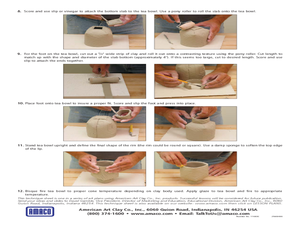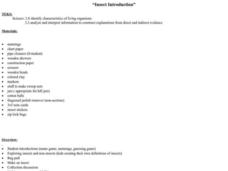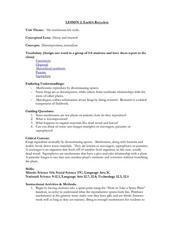Curated OER
Protist Crossword
In this protist worksheet, students complete a crossword puzzle with 34 questions about the behaviour and different types of protists.
Curated OER
Hand Built Tea Bowls
Young scholars follow directions to create clay bowls. In this pottery lesson, students use clay and the pictured tools to follow the directions and create a fire baked tea bowl.
Curated OER
Insect Introduction
Second graders investigate insects and non-insects by creating their own definitions. They complete a series of activities relating to insects.
Curated OER
History Today
Young scholars use the newspaper to determine how history is being made in your community, region or country.They identify the different components that comprise a newspaper. This lesson contains adaptations from elementary to high school.
Curated OER
Time For A Change: Illustrated Plates
Students create illustrated plastic plate designs depicting a physical, chemical, or biological change of some kind after investigating the artwork of porcelain artist Kataro Shirayamadani.
Curated OER
What's the Matter with My Orange?
Students use oranges to informally explore decomposition, dehydration, fermentation, the water cycle, bacteria, yeast, food webs, the needs of living things, and physical vs. chemical change over a period of three or more months.
Curated OER
Touring the Museum
Second graders create a living sculpture using their peers. Working with a partner, they manipulate their partner's arms and legs to create a living statue. They create a story to go along with their sculpture, explaining what the...
Curated OER
Cavern Life: The Food Web
Students explain the importance of elements on a food web. They realize that without light there can be no life. They perform various activities based on grade level.
Curated OER
What is a Solution?
In this solutions activity, students read about how people first learned to use metals and to combine metals to form alloys. Students write an essay telling the story of how ancient people first learned to cause physical changes in metal.
Curated OER
Quartz DBQ
In this quartz worksheet, students read about the chemical composition of quartz and its commercial applications. Then students complete 7 short answer questions.
Curated OER
Sculptures of the Seven Ages
Students simulate sculptors and clay to help them explain abstract phrases in a soliloquy.
Curated OER
Mineral Replacement in Fossil Formation
Fourth graders explore fossils and how they are formed. They create their own "fossils" out of plaster of Paris. They record their findings in their science journals.
Curated OER
The Web Of Life - Overlapping Food Chains
Students perform an activity in which they discover what happens when food chains overlap in an ecosystem and discover the three components of a food web.
Curated OER
Learning Lesson: Measure the Pressure -- The "Wet" Barometer
Young scholars use simple objects to create their own barometer. They have five days to build it and ten days to observe and collect data. They examine thunderstorm safety tips to end the instructional activity.
Curated OER
Earth's Recyclers
Middle schoolers work together in groups to report on different topics related to decomposition. They answer questions and share their answers with the class. They discuss any topic that is unclear.
Curated OER
Odyssey of Life, Part II-The Unknown World
Young scholars complete an experiment in which they observe different natural sample in which they uncover the microbial world. They complete a two part worksheet that accompanies the lesson.
Curated OER
Stereotypes
Third graders define the word stereotypes and identify various examples. In groups, they discuss what they can gather about life and society from other culture groups. They also describe factors that cause conflict and cooperation among...
Curated OER
Collecting Fossils
In this fossils worksheet, students will read about the hobby of fossil collecting and the tools needed for collecting fossils. Students will complete 3 short answer questions based on their reading.
Curated OER
Soil Comparison and Analysis
Students perform tests on different soil samples. In this earth science lesson, students classify the soil into groups according to test results. They write a lab report following a certain criteria.
Science Buddies
Science Buddies: Gel Well: Which Additives Make the Strongest Gelatin?
Gelatin. It's hard to think of another food that is used as frequently on the dinner table as off. You can find it in all sorts of sweet foods, from ice cream, yogurt, and gummy bears, to marshmallows and yellow colorings for sodas. Off...
Akron Children's Hospital
Akron Children's Hospital: Kidshealth: Your House: How to Make It Asthma Safe
Learn how to control the triggers in your house that make asthma worse by reading this article for kids.
Science Museum of Minnesota
Thinking Fountain: Making Mold
Thinking Fountain, from the Science Museum of Minnesota, offers a project in word and picture. With everyday items, you can grow your own mold, both bread mold and penicillin!
TeachEngineering
Teach Engineering: Making Model Microfluidic Devices Using Jell O
Students create large-scale models of microfluidic devices using a process similar to that of the PDMS and plasma bonding that is used in the creation of lab-on-a-chip devices. They use disposable foam plates, plastic bendable straws and...
Cold Spring Harbor Laboratory
Dna From the Beginning: One Gene Makes One Protein
Early research showed that genes code for proteins. This was based on studies using mutant strains of bread mold. This multimedia article includes animations, pictures, video, biographical information, and quiz questions that are...























